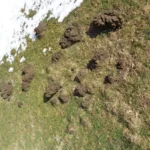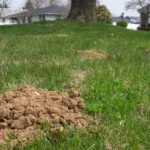As we stroll through our gardens or lawns, we might come across those tiny mounds of earth that have appeared overnight. You may have guessed it- these are the works of moles! But have you ever wondered what motivates these underground creatures to create such intricate tunnels? Moles are fascinating creatures that have baffled scientists and researchers for years with their unique behaviors and abilities. In this article, we’ll delve deep into the world of moles to decode the reasons behind their tunnel digging habits and explore the different methods of controlling them.
What are Moles?
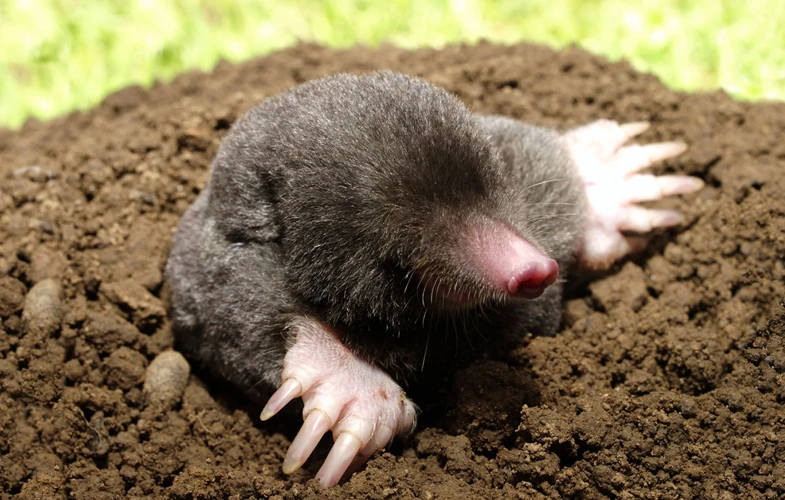
As we delve deeper into the world of insectivores, one creature that stands out with its intricate behavior is the mole. These creatures have a complex network of tunnels that intrigues both biologists and home gardeners alike. To better understand why moles dig tunnels, let’s first understand more about what moles are and their significance in the ecosystem. Check out this link to learn more about moles’ role in the ecosystem.
Types of Moles
Moles are members of the Talpidae family and there are approximately 20 species of moles in the world. There are two types of moles that are most commonly found: Eastern moles (Scalopus aquaticus) and Star-nosed moles (Condylura cristata).
Eastern moles are small, stocky, and have dark grey or brown fur. They are found throughout most of the eastern United States and eastern Canada. They prefer loamy or sandy soils and are often found in grasslands, farmlands, and woodlands. Eastern moles have a long, hairless snout and large, powerful front feet with sharp claws.
Star-nosed moles are found in the northeastern United States and eastern Canada, and are characterized by their unique, star-shaped nose. They are slightly smaller than eastern moles and have dark, velvet-like fur. Star-nosed moles mainly inhabit wet, marshy habitats and are known for their exceptional swimming abilities.
Other types of moles include:
- Hairy-tailed moles (Parascalops breweri) – found in the northeastern United States and eastern Canada
- Coast mole (Scapanus orarius) – found in the Pacific Northwest in the United States
- Broad-footed mole (Scapanus latimanus) – found in the western United States
- Townsend’s mole (Scapanus townsendii) – found in the western United States and southwestern Canada
Each type of mole has its own unique characteristics and behaviors that differentiate them from one another. Understanding the specific species of mole that are common in your region can help in developing effective mole control methods. To learn more about moles and their intricate behavior, visit our Mole Behavior and Prevention page.
Where Do Moles Live?
Moles can be found in different parts of the world, including North America, Europe, and Asia. These underground creatures are native to grasslands, woodlands, and gardens. The type of soil and its moisture level affect their distribution and abundance. Moles prefer moist soil to make it easier for them to dig tunnels. They tend to avoid dry and sandy soils as it hinders their excavation efforts. Moles are also not commonly found in areas with rocky or clay soils as it is difficult for them to dig through.
To provide a better idea about where moles live, here’s a table that shows the habitats of three types of moles:
| Type of Moles | Habitat |
|---|---|
| Eastern mole | Grasslands, deciduous forests, and wooded areas |
| Star-nosed mole | Wetlands and areas close to water |
| Coast mole | Coastal sand dunes, meadows, and grasslands |
It is important to note that moles do not hibernate and are active throughout the year. However, their behavior and pattern of tunneling may change depending on factors such as weather and season. In areas with cold winters, moles tend to dig deeper tunnels below the frost line to avoid freezing temperatures. In areas with hotter climates, moles may dig shallower tunnels closer to the surface to avoid heat stress.
Understanding the habitat preferences and behavior of moles can be useful in preventing damage to your garden or lawn. By creating an environment that is less favorable to moles and implementing preventative measures, you can minimize their activity in your yard. To learn more about preventing damage from moles, check out “Moles’ Diet and How to Prevent Garden Damage” and “Moles vs Voles: Differences and Prevention”. You can also read about how weather affects moles’ behavior in our article on “Weather and Moles’ Behavior” and how moles navigate underground in “Moles’ Behavior and Navigation”.
Moles’ Diet
Moles are insectivores, which means that their diet primarily consists of insects and other small organisms found in soil. However, they may also feed on small vertebrates, such as mice and shrews. Moles are adapted to hunting underground creatures, and their diet may vary depending on the availability of their preferred prey.
Here are some common examples of a mole’s diet:
- Earthworms – These are an important staple in a mole’s diet. Earthworms are rich in protein and other nutrients that can help a mole maintain its high metabolic rate. Moles are able to sense earthworms using their highly sensitive noses and will dig tunnels directly to them.
- Insects – Moles will also feed on a variety of insects, including beetles, ants, and grasshoppers. They are able to find these insects by digging through the soil and detecting their movements.
- Snails and slugs – Although not as common as earthworms and insects, moles will also feed on these creatures if they are available.
- Small vertebrates – Moles have been known to occasionally feed on small rodents such as mice and shrews. However, these are not a major part of their diet and are only consumed opportunistically.
It’s important to note that while moles are often considered pests because of their tunneling behavior, they actually play an important role in soil health. By feeding on insects and other organisms in the soil, they help to aerate the soil and maintain its nutrient balance.
Why Do Moles Dig Tunnels?
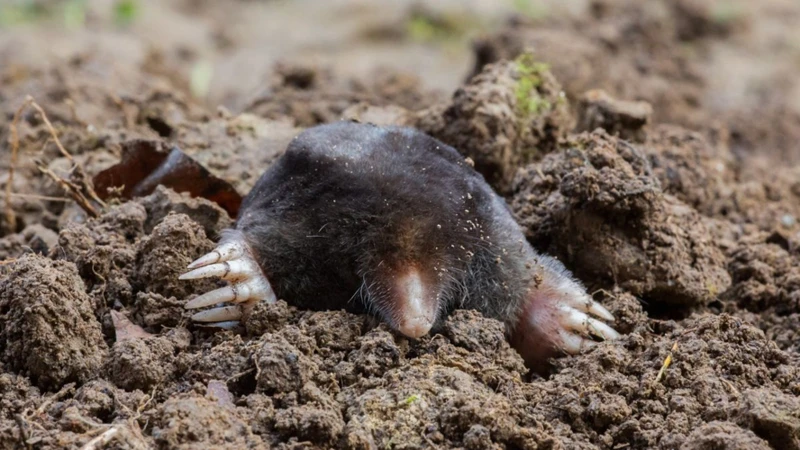
The intricate behavior of moles digging tunnels has been a perplexing subject for years. Their tunneling habits can be quite frustrating, especially when it comes to maintaining a nice yard or garden. But why do moles dig these tunnels in the first place? What could be their reasoning behind all that hard work underground? In this section, we will delve deeper into the answers to these questions and uncover the fascinating reasons behind why moles dig tunnels.
Moles are Insectivores
Moles are primarily insectivores, which means that their diet mainly consists of insects and other small creatures found in the soil. They use their sharp teeth and long snouts to dig through the soil and locate their prey. They have a high metabolism, which requires them to eat their own body weight in food each day.
Some of the common insects and invertebrates that moles feed on include earthworms, grubs, beetles, slugs, and larvae. By consuming these pests, moles play an important role in controlling potential garden and crop damage caused by these pests. They are also able to locate their prey by their sense of smell and vibration, which helps them locate insects that are buried deep in the soil.
Despite their insectivorous diet, moles are often viewed as pests due to their tunneling behavior. They can cause damage to lawns and gardens by uprooting plants and creating unsightly mounds of soil. However, it is important to remember that moles are simply following their natural instincts and are not intentionally causing damage.
There are several reasons why moles dig tunnels, which are discussed in more detail in the following sections of this article.
Moles Need to Move Around
Being active animals, moles need to move around in order to search for food, water, and mates. They are constantly digging tunnels to explore new areas and expand their territories. Moles are able to cover a distance of up to 100 feet per day. In fact, they spend most of their time underground and rarely come to the surface.
This need for movement can be explained by their high metabolic rate. Moles have a rapid metabolism, which means they need to consume a significant amount of food in a short period of time to maintain their energy levels. They also need to drink water regularly to stay hydrated. It is essential for them to move around and search for these resources.
Moreover, moles need to move around to find mates during the breeding season. The breeding season for moles is usually from February to May, and during this time, male moles actively search for female moles. They use their acute sense of smell to locate potential mates.
In addition to this, moles also need to move around to avoid competition with other moles in their territory. Each mole has its own tunnel system, and they can be quite territorial. If two moles cross paths, it can lead to a fight, which can cause injury or even death. It is important for moles to move around and avoid areas that are already occupied by other moles.
The need for movement is a key behavior in the life of moles, and it drives them to dig tunnels to explore new areas, find resources, mate, and avoid competition. Their constant movement is also a key factor in their survival, as it helps them maintain their energy levels, stay hydrated, and avoid threats.
Moles are Solitary Creatures
Moles are a type of mammal that is primarily known for their tunneling behavior. These animals prefer to live alone, and they do not like to interact with anyone except for when it is time to mate. This is why they are termed “solitary creatures.” Some reasons for their solitary nature are:
- Self-Sufficient: Moles are self-sufficient and do not need any assistance from other animals to find food or create their tunnels. They do not form colonies or social groups, unlike some other animals such as bees and ants.
- Territorial: Moles are also territorial animals, meaning that they establish a particular area that they consider their own. They do not tolerate other Moles entering their territory. Male Moles are especially aggressive and will fight to protect their territory and mate.
- Ambush Predators: Moles are ambush predators, they wait for their prey to come to them. There is no benefit to having other Moles around in terms of hunting. In fact, it would only increase competition for food and resources.
- Burrow System: Moles have an elaborate burrow system that also adds to their solitary nature. They create their burrows to provide them with shelter and security. Having other Moles around in the same burrow system could create confusion and pose a risk to their safety.
Moles prefer to work and live in solitude, which is why they are classified as solitary creatures. Their burrow systems allow them to lead a self-sufficient life without the need for social interactions.
Protection Against Predators
One of the main reasons why moles dig tunnels is to protect themselves against predators. Moles are small creatures that are susceptible to attack from larger predators. These predators include foxes, snakes, badgers, and birds of prey. By burrowing in the ground, moles can hide from these predators, making it more difficult for them to be caught.
Moles have several adaptations that make them suitable for living in the underground tunnels. Firstly, their small size and streamlined bodies make it easy for them to maneuver through the tunnels, allowing them to escape predators quickly. Secondly, moles have sharp claws that they use to dig tunnels and burrows. These claws are also useful for defending themselves against predators.
Moles also have thick, tough skin that protects them from the rough edges of the tunnel walls. This skin allows them to move quickly through the tunnels without sustaining injuries.
Moles have a unique sense of touch that allows them to detect predators approaching from above. This sense of touch is achieved through the use of sensory hairs on their bodies, which helps them to sense the vibrations caused by the movements of predators such as foxes or badgers.
The tunnels that moles dig provide them with a safe place to live and hide from predators. The underground environment allows them to remain hidden from predators, making it more difficult for them to be caught. Moles have evolved several physical adaptations to help them protect themselves from predators and survive in their underground habitats.
Maintaining Ideal Soil Conditions
Moles also dig tunnels for the purpose of maintaining ideal soil conditions. As they burrow through the ground, they help to break up compacted soil and aerate it, promoting healthy root growth and allowing for better water drainage. Moles create pockets and channels in the soil that can help to redistribute nutrients and organic matter throughout the earth, contributing to a healthier ecosystem.
Through their digging behavior, moles also help to control the populations of certain pests that may be harmful to plants and vegetation. For example, moles are known to eat grubs, which can cause extensive damage to lawns and gardens. By keeping these pests under control, moles indirectly contribute to the growth and health of plant life in their environment.
However, while moles may have some positive benefits for soil health, their digging can also be damaging to some crops and other vegetation. In agricultural settings, for example, moles may uproot young plants or damage the roots of established ones, causing significant losses for farmers.
It is important to consider the complex nature of moles’ behavior and the potential effects on the surrounding environment before determining the best course of action for dealing with these animals.
How Do Moles Build Tunnels?
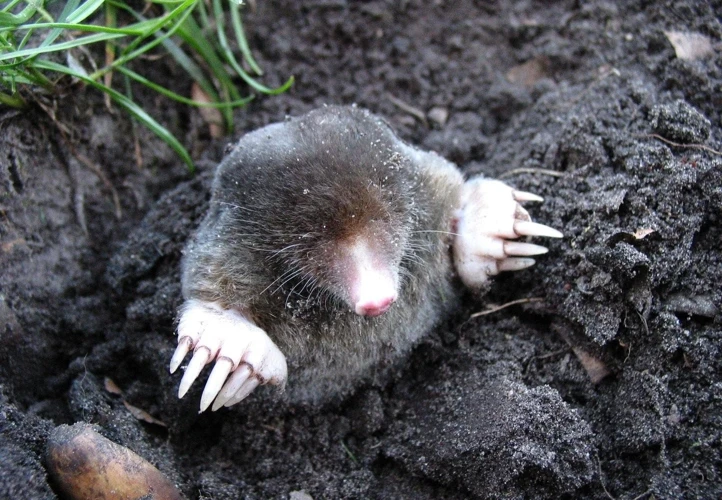
One of the most intriguing aspects of moles is the way they build their intricate tunnel systems. These underground passageways allow moles to move around and find food, all while avoiding predators and maintaining ideal soil conditions. But how exactly do moles construct these tunnels? What is the difference between feeding and living tunnels, and how do molehills and surface tunnels fit into the equation? Let’s delve deeper into the fascinating world of moles and uncover the secrets behind their tunnel-building techniques.
The Difference between Feeding and Living Tunnels
Moles build two types of tunnels: feeding tunnels and living tunnels. Feeding tunnels are typically located near the surface and can be identified by the ridges of soil that they create. These tunnels are used by moles to search for their main food source – earthworms. When moles detect an earthworm, they quickly dig directly downwards, grab the worm with their teeth and go back up to the surface to eat it. These tunnels are typically short-lived and are used infrequently.
On the other hand, living tunnels run deeper into the soil, and are the moles’ primary mode of movement. These tunnels are more complex and are always in use. Moles use these tunnels for traveling, nesting, and raising their young. They create a network of tunnels which can span several meters and connect different burrows to each other.
It’s important to note that living tunnels also serve as a food storage area for moles. Since moles are solitary animals, they need to stock up on food to survive during periods when food is scarce. Moles create a cache of worms and other insects in chambers located along their living tunnels so they always have a food source nearby.
While feeding tunnels can be relatively easy to spot, living tunnels are usually buried deep in the soil, making them more difficult to detect.
Molehills and Surface Tunnels
Molehills and Surface Tunnels
As moles dig tunnels underground, they create molehills or small piles of dirt on the surface. These molehills are often easy to spot, and can actually be useful in identifying where moles are active. Molehills are created when moles excavate tunnels and push the soil up to the surface. They are typically created at an angle to avoid collapsing, and can vary in size depending on how deep the underlying tunnel is.
In addition to molehills, moles also create surface tunnels. These tunnels are much shallower than the feeding tunnels and are closer to the surface, and serve as a way for moles to move between their feeding and living tunnels. Surface tunnels are also used to quickly escape to the surface for air, or as a way for young moles to disperse from their mother’s territory.
Both molehills and surface tunnels can be a nuisance to property owners and gardeners, as it can disrupt the soil and damage plant roots. It’s important to properly identify the type of tunnel and to use appropriate control methods.
To distinguish between molehills and surface tunnels, look at the shape and size of the disturbance. Molehills are typically conical and can be several inches tall, while surface tunnels are more shallow and have a slight depression in the middle. Using this knowledge, property owners can better target control methods to minimize the damage caused by moles.
Moles’ Physical Abilities
Moles may seem small, but they are incredibly powerful creatures with impressive physical abilities. Here are some of the most notable ones:
- Strong Forelimbs: Moles have exceptionally strong front paws that they use to dig tunnels. These paws feature long, sharp claws that allow them to break apart soil and create their distinctive tunnel networks. Interestingly, moles’ claws are also reversible, meaning they can move backward and forward as necessary to facilitate efficient digging.
- Good Sense of Smell: As insectivores, moles use their sense of smell to locate their prey. They have an acute sense of smell that allows them to detect insects and other small animals, even when they are buried deep beneath the ground.
- Poor Eyesight: Despite their ability to find their prey with their sense of smell, moles have poor eyesight. They have small eyes that are covered by a layer of skin, which protects them from dirt and debris while digging.
- Flexible Spines: Moles have very flexible spines that allow them to move through their tunnels quickly and efficiently. This flexibility also enables them to turn around and maneuver in tight spaces with ease.
- High Metabolism: Moles have incredibly high metabolisms, which means they need to eat a lot in order to maintain their energy levels. In fact, moles will consume up to 80% of their body weight in food every day! This high metabolism is necessary for their active tunneling lifestyle.
With these physical abilities, moles are well-equipped for their tunneling lifestyle. However, their behavior can cause problems for humans, which is why it’s important to understand how to control them effectively and humanely.
Moles Control Methods
As much as moles might be fascinating creatures, they can be quite the nuisance to our gardens and yards. Their tunnels can damage plants’ roots and create unsightly mounds of soil. Unfortunately, getting rid of them can prove to be a demanding and often frustrating task. There are several mole control methods available, each with their own advantages and drawbacks. In this section, we’ll take a closer look at some of the most effective and humane ways to deal with these persistent diggers.
Humane Methods
One of the most important things to keep in mind when dealing with moles is to treat them humanely. Here are some humane methods for controlling moles:
- Planting natural deterrence plants like marigold, alliums, and daffodils, since moles do not like the smell or taste of them.
- Repelling moles using castor oil or hot pepper spray, since the strong odor and taste of them can be effective mole deterrents.
- Using noise devices, such as sonic stakes or wind chimes, to disrupt moles’ sense of security and create an uncomfortable environment for them.
- Encouraging natural predators, like snakes or owls, to inhabit the area where the moles are living. This will help to naturally reduce the mole population without causing harm.
- Removing grubs and other insects from the lawn, since soil filled with insects can attract moles to the area.
These humane methods can all be effective, but they do require patience and continued effort. It is important to remember that moles are simply trying to survive and that humane methods should always be the first approach to controlling their behavior.
Exclusion
Exclusion Method
The exclusion method is a preventative measure that involves creating physical barriers to keep moles out of an area. This method aims to prevent moles from entering through areas that are vulnerable to infestation. Here are some effective ways to exclude moles:
- Install Fences: You can install fences around your garden or entire yard. The fencing material should be buried at least 30cm below the ground and should be high enough to prevent moles from climbing over it.
- Use Hardware Cloth: This is a heavy-gauge wire mesh with small openings that can prevent moles from digging through it. It can be installed around garden beds or tree trunks to create a barrier.
- Use Gravel: Moles don’t like to dig through gravel because it is difficult for them to tunnel through. Laying a layer of gravel around areas that you want to protect can help deter moles from entering the area.
- Use Repellents: You can use natural repellents like castor oil or predator urine around the borders to keep moles at bay. Commercial repellents can also be used but they may have a detrimental effect on non-target animals if not used properly
Conclusion: The exclusion method is an effective way to prevent moles from entering an area. By creating physical barriers and deterring moles with natural and commercial repellents, this method can be an excellent way to deter moles from causing damage to your garden or lawn.
Mechanical Barriers
One effective method to control moles’ tunneling behavior is through the use of mechanical barriers. These barriers are physical objects placed beneath the ground’s surface to prevent moles from tunneling in certain areas.
There are several types of mechanical barriers that can be used, including mesh wire, hardware cloth, and gravel. Each of these barriers works differently but is designed to achieve the same goal: preventing moles from tunneling.
Mesh wire and hardware cloth are both made of small, closely spaced wires that are woven together to create a barrier. Mesh wire is a more flexible material, which makes it ideal for curved areas, while hardware cloth is sturdier and better suited for straight lines.
Gravel is an effective physical barrier because it is difficult for moles to tunnel through. When placed beneath the surface, the gravel creates a barrier that makes it difficult for moles to dig.
One disadvantage of mechanical barriers is that they can be difficult to install. The barriers must be placed deep enough beneath the surface to prevent moles from digging under them. However, if installed correctly, mechanical barriers can be an effective way to control moles’ tunneling behavior.
Here is a table summarizing the advantages and disadvantages of using mechanical barriers:
| Advantages | Disadvantages |
|---|---|
| Effective at preventing moles from tunneling | Can be difficult to install |
| Durable and long-lasting | May be visually unappealing |
| Relatively low cost | May require regular maintenance |
Mechanical barriers are an effective and non-toxic way to control moles’ tunneling behavior. However, they must be installed correctly and may require regular maintenance to ensure that they are still functioning properly.
Natural Predators
One of the natural ways to control moles in your garden is through their natural predators. There are numerous animals that feed on moles as a part of their natural diet.
Here are some of the natural predators of moles:
- Owls: these birds of prey are known to hunt for moles, as they can easily locate them underground by their sound, and they are stealth fliers that can quietly capture their prey.
- Hawks: hawks have sharp talons, making them skilled hunters of small mammals like moles.
- Foxes: these cunning animals are also known to hunt for moles, either by digging them out or catching them above ground before they can move back into their burrows.
- Weasels: weasels are small and agile predators that can easily enter the narrow burrows and tunnels of moles to catch them.
- Cats: domestic and feral cats are notorious for their hunting instincts, and they are known to be efficient mole hunters as well.
- Dogs: some breeds of dogs, like Jack Russell Terriers, have a natural talent for hunting moles, and have been trained to dig them out of their burrows.
It is important to note that while these predators can help control the mole population in your garden, they may also prey on other small mammals or birds that you may want to protect. Additionally, relying solely on natural predators may not solve the mole problem completely, and other mole control methods may still be necessary.
Chemical Control and Traps
One of the methods of controlling mole populations is through the use of chemical control and traps. However, it should be noted that this method can also cause harm to non-target animals and is, therefore, not always recommended.
Chemical control involves using poisons to eliminate moles. However, this can be dangerous to other animals in the surrounding areas, such as pets and wildlife. It may also harm the environment and humans who come in contact with the poison.
Traps, on the other hand, are one of the more humane methods of mole control. There are a variety of traps available, including scissor traps, harpoon traps, and box traps. Scissor traps are designed to catch the mole in the tunnel, while harpoon traps are placed into the ground and triggered when a mole comes into contact with them. Box traps allow for the safe capture and release of moles.
When setting traps, it is important to place them in areas where mole activity has been observed. This can be identified by looking for molehills and tunnels in the ground. It is also important to handle mole traps with care, as they can cause injury if not used properly.
While chemical control and traps can be effective methods of controlling moles, it is important to consider the potential harm they may cause to non-target animals and the environment. It is recommended to consider other methods of control first and only use these methods as a last resort.
| Pros | Cons |
|---|---|
| Effective in controlling mole populations | Potential harm to non-target animals |
| Can be quick and efficient | May harm the environment |
| Easy to set up and use | May cause harm to humans if not used properly |
| Traps can be humane if used correctly | Not always a long-term solution |
Conclusion
After delving into the intricate behavior of moles and their tunnel digging habits, it is evident that these small creatures have a significant impact on the environment they inhabit. Understanding why moles dig tunnels is essential in managing mole populations and preventing damage to lawns and gardens.
Despite the common perception of moles as pests, they play an important role in controlling insect populations and improving soil health. Through their tunnel digging, they provide aeration to the soil, which allows for better water and nutrient absorption. However, when moles dig too many tunnels, they can damage the root system of plants, which can ultimately harm the entire ecosystem.
Various factors drive the behavior of moles, including their diet, need for movement, and desire for protection. Understanding these factors can give us insights into the reasons behind mole behavior and how we can respond to it. There are several humane methods of controlling moles, including exclusion and natural predators, as well as mechanical barriers and traps. However, it is essential to approach mole control with care and caution, as many methods can harm not only moles but also other wildlife in the area.
In conclusion, moles are fascinating creatures that play an important role in the ecosystem, and their tunnel digging habits are a natural behavior that should be managed with care. By understanding why moles dig tunnels and how they build them, we can better manage populations and prevent damage to our lawns and gardens. Adopting humane methods of mole control and respecting the natural behavior of these small creatures can help to maintain the delicate balance of nature in our environment.
Frequently Asked Questions
What kind of insects do moles eat?
Moles primarily feed on earthworms, but they also eat other insects and larvae found in soil.
Can moles see or hear well?
No, moles have very poor eyesight and hearing. They rely on their sense of touch and smell to find food and navigate their tunnels.
Do all types of moles dig tunnels?
Yes, all types of moles are burrowing animals and dig tunnels for various reasons.
Why do moles create molehills?
Molehills are created when moles dig tunnels and push soil to the surface. This allows them to create new tunnels and also acts as a way to mark their territory.
Can moles damage plants and gardens?
Yes, moles can damage plant roots and create tunnels that can lead to soil erosion. However, they primarily feed on insects and do not intentionally harm plants.
Why are moles considered pests?
Moles are considered pests because their tunnels can damage lawns, golf courses, and other landscaped areas. They are also difficult to control and can be a nuisance to homeowners.
Can moles transmit diseases to humans or pets?
No, moles do not transmit diseases to humans or pets.
Do moles hibernate?
No, moles do not hibernate but they do become less active during the winter months.
How can I tell if I have a mole problem?
If you notice molehills or surface tunnels in your lawn or garden, or see damage to plant roots, you may have a mole problem. Additionally, if you see moles burrowing or hear them scurrying around underground, you likely have a mole infestation.
What is the most effective way to control moles?
The most effective way to control moles is by using a combination of exclusion techniques, natural predators, and humane traps. Chemical control should only be used as a last resort.





